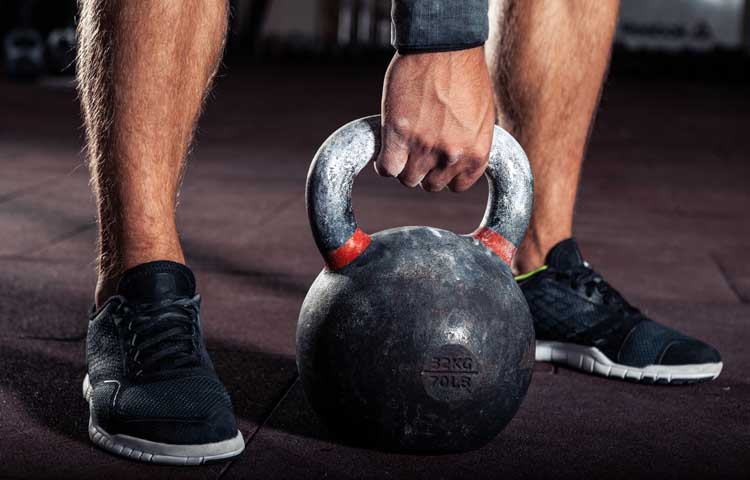
For years kettlebells were considered the preserve of Russian soldiers and circus strongmen.
However their fairly recent increase in popularity has moved them away from the dusty confines of gym corners to the centre of every self-respecting athlete’s training regime.
The reasons for this are simple: they’re compact, easy to use and they get results – fast.
“Training with kettlebells gives you the best of both worlds,” says Stuart Amory, PT and self-styled ‘accountability coach’.
“They’re great tools for building strength while at the same time challenging your cardiovascular system.
“The movements work multiple muscle groups simultaneously, strengthening your core and those supporting muscles that get neglected with traditional gym-based training.”
They’re of particular interest to runners as they strengthen the parts that simple running can’t reach.
“A lot of runners don’t do core training,” says Amory. “While this may not seemingly effect their performance over short distances, when you move into endurance racing it’s your core that stops you from collapse forward as you fatigue.
“A weak core can result in your legs taking the weight of your body, which is the last thing you want when you’ve still got a way to go during longer races.”
If you’re used to high intensity interval training (HIIT) you can use the same principles with a kettlebell workout.
“You can take an equivalent sprint or hill training timings and apply them to a kettlebell workout,” says Amory.
“Make sure you spend at least 10 minutes warming up, as you should with any training, then perform the kettlebell exercises during the designated sprint periods and stick to the same rest timings too.”
Don’t forget to put the kettlebells on the floor during the down time.
“You’ll be increasing your back strength, posterior chain, hamstrings and stabilising muscles,” says Amory.
“It’s low impact and doesn’t put any pressure on joints and add to any wear and tear from doing long miles.”
And it’s not just wannabe ultrarunners who can benefit either. Amory’s own experience of kettlebell training saw a marked improvement in his sprint time.
“A few years ago I trained exclusively with kettlebells to see exactly what improvements they made to my 5K time,” he says.
“To my amazement the next parkrun I did saw me take 1:15 minutes off my personal best. I couldn’t believe it.”
Amory puts this down to another benefit of the ‘bells: breath training.
“A HIIT session with kettlebells is as much a cardio as it is a strength and conditioning one,” he says.
“It allows you to breath with the exercise and encourages you to avoid puffing and panting.
“These controlled breathing skills can be transferred to your running, and help with what I call the ‘golden breath’: the ability to breath deep and steady when under pressure.
“It’s essential to continue to get oxygen into your blood stream while running and practising your breathing while exercising in this way can only improve your ability to do that.”
You don’t have to be a member of a gym to enjoy the benefits of the ‘bells: they’re reasonably cheap (from £14, wolverson-fitness.co.uk) and store away easily.
Plus you can use them anywhere, although outside is preferable if you want to avoid any accidents with furniture or exposed floorboards.
Try adding the session over to your training once a week and then either increase the frequency or number of rounds per session – we guarantee you’ll soon be a kettlebell convert.
What to do
To begin with perform 15-20 reps of each move then rest for 30 seconds before moving on to the next.
Once you done all four, rest for 60 second then perform another round. As you progress, start skipping the 30-second rest periods until your performing all four moves without rest, stopping only for the 60-second rest.
As you get stronger increase the reps and/or rounds accordingly.
And remember: form is everything. Don’t go too heavy until you can confidently complete a round without good posture.
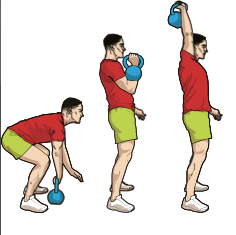
1. Kettlebell clean and press
Muscles: Shoulders, core, hamstrings, triceps
Why do it?
Strengthen core and posterior chain
Technique:
– Place a kettlebell between your feet
– Keeping a straight back, push out your backside and bend your knees
– Pick up the kettlebell with one hand, other arm out to the side for balance.
– Straighten your legs, push your hips forward and bring the kettlebell up to your shoulder flipping it so it rests on your forearm.
– Quickly push the kettlebell over your head, hold, then return to the floor along the same route and repeat.
Top tip:
Keep your spare arm straight and bring it to the side for balance as you move through the first phase of the exercise.
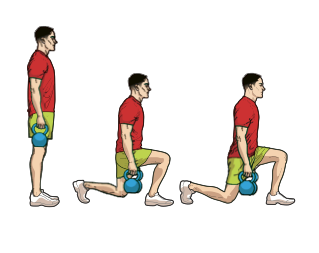
2. Kettlebell lunge
Muscles: Core, glutes, quads, calves
Why do it?
Strengthen legs and improve posture
Technique:
– Stand with you feet together, kettlebell in each hand
– Looking straight ahead take a big step forward with one leg
– Drop down so there’s a 90° angle in your front leg and your back knee is kissing the ground
– Push back off your front leg, straighten your rear leg and return to the start and repeat.
– Finish your reps on one leg before moving onto the other.
Top tip:
Keep your shoulders back and try to keep your upper body still throughout.
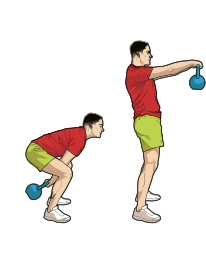
3. Kettlebell swing
Muscles: Lower back, shoulders, core, hamstrings
Why do it?
To mobilise your joints and work your entire posterior chain
Technique:
– Place a kettlebell between your feet
– Keeping a straight back, push out your backside and bend your knees
– Pick up the kettlebell with both hands, look straight ahead and forcefully swing the kettlebell between your legs
– Reverse the swing and drive with your hips to bring the kettlebell to around eye level
– Let it swing back between your legs and repeat
Top tip:
Keep a straight back throughout and make sure the momentum is coming from your hip
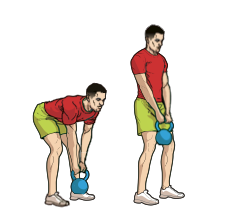
4. Kettlebell straight-legged deadlift
Muscles: Core, lower back, glutes, hamstrings
Why do it?
Strengthen hamstrings, core and lower back.
Technique:
– Place a kettlebell between your feet
– Keeping a straight back, push out your backside and with a slight bend in your legs, bend at the hips and pick it up with both hands.
– Push your hips forward and stand up straight bringing the kettle bell up to your thighs.
– Pause then repeat being sure not to bounce at the bottom of the move.
Top tip:
If you’re feeling particularly flexible you can stand on a step to allow you to lower the kettlebell further. Don’t try this on the first attempt though!






